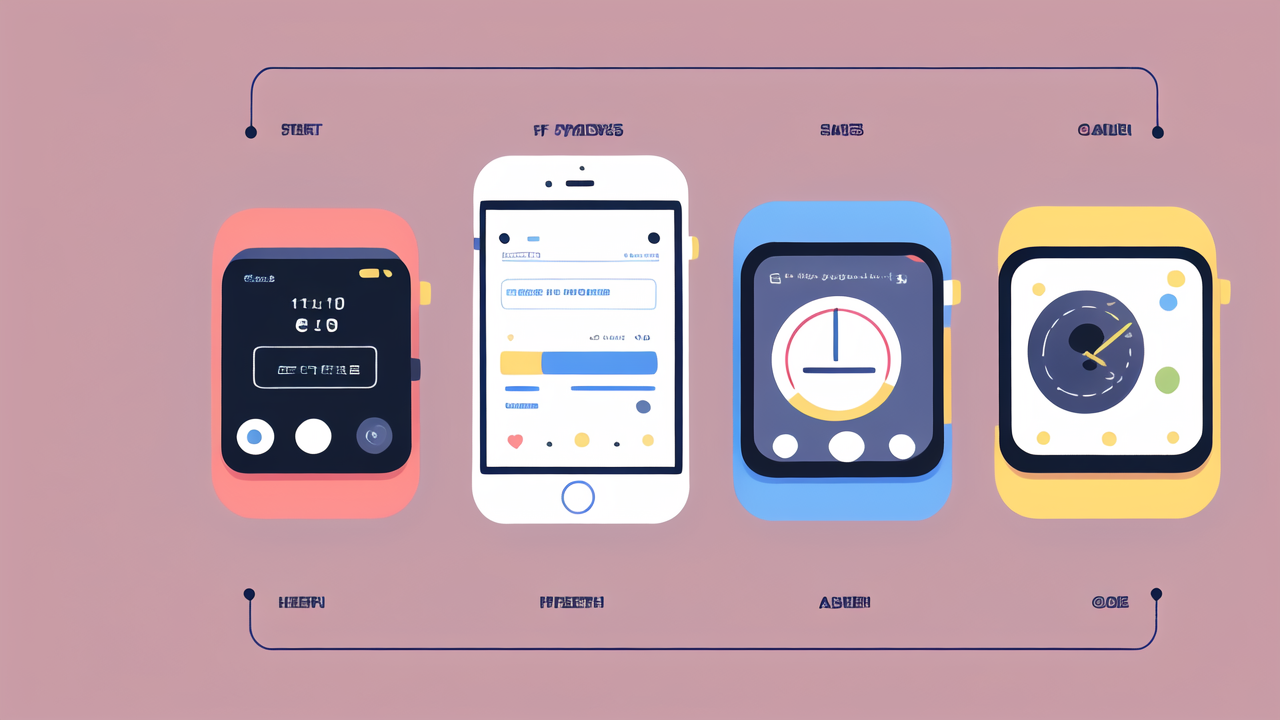Understanding Smart Bands: A New Era in Fitness Technology
What Are Smart Bands?
Smart bands are wearable devices that track fitness and health data. They're sleek, lightweight, and packed with sensors. These bands monitor steps, heart rate, sleep, and more. They sync with smartphones to provide detailed insights.

Smart bands are more than just pedometers. They offer a range of features for fitness enthusiasts. Some can measure blood oxygen levels and stress. Others track specific workouts like swimming or cycling.
The key appeal of smart bands is their ease of use. They're comfortable to wear all day. Many are water-resistant, allowing for 24/7 tracking. This continuous data collection gives users a complete picture of their health.
The Evolution of Fitness Wearables in the United States
Fitness wearables have come a long way in the US. The journey began with simple pedometers in the 1960s. These devices only counted steps. They were bulky and not very accurate.
The 2000s saw the rise of digital pedometers. These were more precise and could store data. Heart rate monitors also became popular among athletes.
In 2009, Fitbit launched its first tracker. This marked the beginning of the smart band era. Since then, the market has exploded. Major tech companies like Apple and Samsung entered the scene.
Today's smart bands are mini-computers on your wrist. They offer GPS tracking, smartphone notifications, and even contactless payments. The focus has shifted from just counting steps to overall health management.
Key Differences Between Smart Bands and Traditional Fitness Equipment
Smart bands offer several advantages over traditional fitness gear. Here are the key differences:
- Portability: Smart bands are lightweight and always with you. Traditional equipment is often bulky and stationary.
- Data tracking: Smart bands automatically log your activity. With traditional equipment, you often need to record data manually.
- Comprehensive monitoring: Smart bands track various health metrics 24/7. Traditional equipment usually focuses on one aspect, like weight or heart rate.
- Motivation: Smart bands provide real-time feedback and goal setting. This can be more motivating than using traditional equipment.
- Cost-effective: A single smart band can replace multiple pieces of fitness equipment.
- Integration: Smart bands sync with apps, creating a holistic health picture. Traditional equipment often lacks this connectivity.
- Accuracy: Modern smart bands offer precise measurements. Some traditional tools may be less accurate or consistent.
Smart bands are not replacing all traditional equipment. But they're changing how we approach fitness and body measurement.
The Impact of Smart Bands on Body Measurement Accuracy
Advancements in Smart Band Technology for Body Measurement
Smart bands have made significant strides in body measurement technology. Early models focused on step counting and basic calorie estimates. Now, they offer a range of advanced measurements.

One key advancement is in heart rate monitoring. Many smart bands use photoplethysmography (PPG) sensors. These shine light into the skin to detect blood flow changes. This allows for continuous heart rate tracking throughout the day.
Body composition measurement is another area of progress. Some smart bands can estimate body fat percentage. They do this using bioelectrical impedance analysis (BIA). This sends a small electrical current through the body.
Sleep tracking has also improved. Smart bands can now detect different sleep stages. They measure things like REM sleep, deep sleep, and sleep interruptions. This gives users a clearer picture of their sleep quality.
New sensors are expanding measurement capabilities. Some bands can now measure blood oxygen levels. Others can detect skin temperature changes. These features provide more comprehensive health data.
How Smart Bands are Revolutionizing the Health and Wellness Industry
Smart bands are transforming how we approach health and wellness. They're making data-driven health management accessible to everyone. Here's how:
- Personalized insights: Smart bands collect vast amounts of data. AI algorithms then analyze this data to provide personalized health tips.
- Early detection: Continuous monitoring can spot potential health issues early. For example, unusual heart rate patterns or sleep disturbances.
- Fitness motivation: Goal setting and progress tracking features encourage regular exercise.
- Remote health monitoring: Healthcare providers can access patient data remotely. This is especially useful for managing chronic conditions.
- Integration with healthcare systems: Some smart bands can share data directly with electronic health records.
- Stress management: Many smart bands now offer stress tracking and guided breathing exercises.
- Community building: Many smart band apps have social features. Users can connect, compete, and support each other's health goals.
These innovations are making preventive healthcare more accessible and engaging.
Case Studies: Success Stories of Body Transformation with Smart Bands
Smart bands have helped many people achieve significant health improvements. Here are a few success stories:
Case 1: Sarah, 35, lost 30 pounds in 6 months using a smart band. The device helped her track her daily steps and calorie intake. She set gradual goals and celebrated each milestone. The sleep tracking feature also helped her improve her sleep habits.
Case 2: John, 50, managed his hypertension better with a smart band. He monitored his heart rate and activity levels daily. This data helped his doctor adjust his medication more effectively. John also reduced his stress levels using the band's guided breathing exercises.
Case 3: Emma, 28, an amateur runner, improved her marathon time. Her smart band provided detailed running metrics. She used this data to optimize her training routine. The recovery tracking feature helped her avoid overtraining.
Case 4: Tom, 62, detected early signs of atrial fibrillation thanks to his smart band. The device noticed irregular heart rhythms during his sleep. Tom took this data to his doctor, leading to early treatment.
These stories show how smart bands can support various health and fitness goals. They provide the tools and motivation for lasting lifestyle changes.
The Future of Fitness: Trends and Predictions in the Smart Band Market
Emerging Trends in Smart Band Usage Across the Fitness Industry
The fitness industry is rapidly adopting smart band technology. Here are some emerging trends:

- Integration with gym equipment: Smart bands are starting to connect with treadmills and other gym machines. This allows for more accurate workout tracking.
- Virtual personal training: Some smart bands now offer AI-powered workout suggestions. These adapt based on your fitness level and goals.
- Group fitness challenges: Gyms and fitness studios are using smart bands for group competitions. This adds a fun, social element to workouts.
- Corporate wellness programs: Companies are providing smart bands to employees. They use them to promote health and track program effectiveness.
- Gamification of fitness: Many smart band apps now include game-like elements. Users can earn points, badges, or virtual rewards for meeting fitness goals.
- Subscription-based fitness content: Some smart band makers now offer premium content subscriptions. These include guided workouts and in-depth health insights.
- Integration with smart home devices: Smart bands are beginning to connect with other smart home tech. For example, adjusting room temperature based on your body heat.
These trends show how smart bands are becoming central to modern fitness routines.
Expert Predictions for the Next Big Thing in Fitness Wearables
Experts in the field have exciting predictions for the future of smart bands. Here are some possibilities:
- Advanced health monitoring: Future smart bands might detect early signs of diseases like diabetes or heart disease.
- Emotion tracking: Some experts predict smart bands will be able to detect and analyze mood changes.
- Augmented reality integration: Smart bands could provide real-time fitness data overlays in AR glasses.
- Improved battery life: New power technologies could extend smart band battery life to weeks or months.
- Eco-friendly materials: Future smart bands may be made from sustainable or biodegradable materials.
- Skin-adhered sensors: Ultra-thin, patch-like smart bands could offer even more accurate body measurements.
- Customizable designs: 3D printing could allow users to design their own smart band shapes and styles.
These predictions show that smart bands will likely become even more powerful and personalized.
Integrating Smart Bands into a Comprehensive Fitness Strategy
To get the most out of smart bands, they should be part of a broader fitness plan. Here's how to integrate them effectively:
- Set realistic goals: Use your smart band data to set achievable, gradual fitness targets.
- Combine with nutrition tracking: Many smart band apps allow food logging. Use this to balance your diet and exercise.
- Use sleep insights: Pay attention to your sleep data. Good sleep is crucial for fitness and recovery.
- Join challenges: Participate in app-based fitness challenges to stay motivated.
- Share data with your healthcare provider: Your smart band data can be valuable for check-ups and health planning.
- Complement with strength training: Smart bands excel at cardio tracking. Add strength exercises for a balanced routine.
- Regular calibration: Ensure your smart band is properly set up and calibrated for accuracy.
Remember, a smart band is a tool, not a magic solution. It's most effective when used as part of a committed approach to health and fitness.




Leave a comment
This site is protected by hCaptcha and the hCaptcha Privacy Policy and Terms of Service apply.